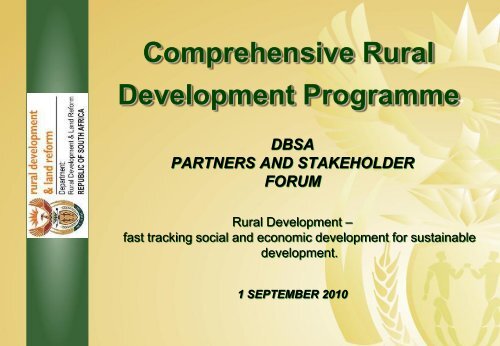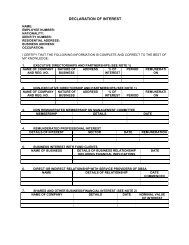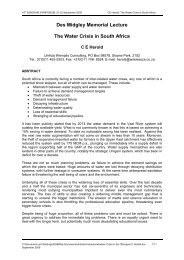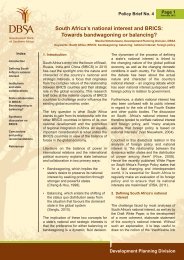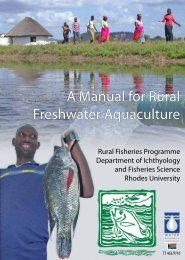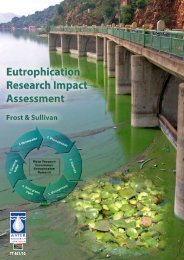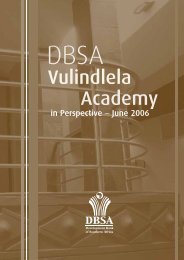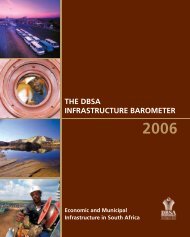Comprehensive Rural Development Programme
Comprehensive Rural Development Programme
Comprehensive Rural Development Programme
You also want an ePaper? Increase the reach of your titles
YUMPU automatically turns print PDFs into web optimized ePapers that Google loves.
<strong>Comprehensive</strong> <strong>Rural</strong><strong>Development</strong> <strong>Programme</strong>DBSAPARTNERS AND STAKEHOLDERFORUM<strong>Rural</strong> <strong>Development</strong> –fast tracking social and economic development for sustainabledevelopment.1 SEPTEMBER 2010
Presentation outline1. Definition of <strong>Rural</strong>2. Understanding rural areas3. Challenges facing rural areas4. The <strong>Comprehensive</strong> <strong>Rural</strong> <strong>Development</strong> <strong>Programme</strong>5. Outcome 7: Sustainable Livelihoods and Food Securityfor All.6. Way forward2
3Defining <strong>Rural</strong>
DEFINITION OF RURAL AREASThe <strong>Rural</strong> <strong>Development</strong> Framework, adopted by theGovernment in 1997, defined rural areas as:• “Sparsely populated areas in which people farm ordepend on natural resources, including villages and smalltowns that are dispersed throughout these areas.• They include large settlements in the former homelands,created by apartheid removals, which depend onmigratory labour and remittances for their survival.”• “<strong>Rural</strong>ity” refers to a way of life, a state of mind and aculture which revolves around land, livestock, croppingand community.
5Challenges facing <strong>Rural</strong> Areas
CHALLENGES FACING RURAL AREASLessons from the ISRDP programme and CRDP sitesindicate that the challenges of rural areas include thefollowing:• Under utilisation and/or unsustainable use of naturalresources• poor or lack of access to socio-economic infrastructureand services, public amenities and governmentservices (e.g. industrial parks lying idle especially in the formerhomeland areas)• lack of access to water or lack of water sources forboth household and agricultural development• low literacy, skills levels and migratory labour practices
CHALLENGES FACING RURAL AREAS (cont)• decay of the social fabric (child headed households, crime,family disputes and lack of Ubuntu)• death of cultural progress• unresolved restitution and land tenure issues• townships not formally established thus hindering serviceprovision and development• dependence on socialsecuritygrants and other forms of social• unexploited opportunities in agriculture, tourism, miningand manufacturing
8THE COMPREHENSIVE RURALDEVELOPMENT PROGRAMME
STRATEGIC PLANNING FRAMEWORKVisionVibrant, Sustainable and Equitable <strong>Rural</strong> CommunitiesStrategyAgrarian transformation, meaning the „rapid and fundamentalchange in the relations (Systems and patterns of ownershipand control)of land, livestock, cropping and community‟Strategic ObjectiveSocial Cohesion and <strong>Development</strong>9
INTRODUCTION• The Department of <strong>Rural</strong> <strong>Development</strong> and Land Reform (DRDLR) hasdeveloped the <strong>Comprehensive</strong> <strong>Rural</strong> <strong>Development</strong> <strong>Programme</strong>.• The CRDP requires active participation by all stakeholders• <strong>Rural</strong> people must take the centre stage in the improvement of their ownquality of life.• In the current financial year the DRDLR identified and commenced withplanning in 9 pilot sites, spanning 21 wards.• The pilot sites have been testing grounds for the CRDP models that isconstantly being fine tuned and improved on.• A further 160 CRDP sites will be identified and targeted over the next 5year period.10
Proposed Number of Households to be supported by theCRDP by 2014FINANCIAL YEARNumber of<strong>Rural</strong> Wardsper annumEstimated number ofHouseholds per rural wardreached (as reflected in theState of Local GovernmentReport ,2009)Estimated number of<strong>Rural</strong> HouseholdsSupported2009/10 21 2 700 56 7002010/11 25 2 700 67 5002011/12 32 2 700 86 4002012/13 37 2 700 99 9002013/14 45 2 700 121 500TOTAL 160 13 500 432 000YEARImpact of the CRDP by 2014 (number of people)Average HouseholdSize in <strong>Rural</strong> Areas(Statsa, 2001; CS,2007)Number of HouseholdsSupportedNumber of peopleaffected by the CRD<strong>Programme</strong>2014 4.5 432 000 1 944 000
DRDLR ROLE IN RURAL DEVELOPMENT‣ The Department of <strong>Rural</strong> <strong>Development</strong> and Land Reform act as aninitiator, facilitator and coordinator and catalyst in ruraldevelopment interventions:• Facilitator: The Department will play an active role in the facilitation ofcommunities and will also facilitate interventions in areas where theDepartment has no expertise/funding but has identified other sectordepartments/stakeholders to contribute to the CRDP vision for thatarea/province.• Coordinator: The department will coordinate strategies, policies andmobilise resources from stakeholders to contribute to the objectives of therural development programme.• Initiator: The Department will initiate interventions/strategies in ruralareas as part of an integrated approach.• Catalyst: The Department will play a change agent role and assist in thecomplete transformation of the rural space in terms of policies,programmes and projects for the ultimate aim of achieving vibrant andsustainable rural communities.
CURRENT CRDP PILOT SITES INRELATION TO ISRDP NODESKgalagadiGreaterSekhukhuneZululandMaluti-a-Phofung 42 7MarulengBushbuckridgeUmkhanyakudeUmzinyathiAlfred Nzo UmzimkhuluUkhahlamba5 UguCentral KarooOR TamboChris Hani689131. Muyexe2. Riemvasmaak3. Mkhondo4. Diyatalawa/Mokohlokoe5. Mhlonhlo6. Dysselsdorp7. Msinga8. Disake/Matlametlong/Mokgalaneng9. Gauteng
WARDS CURRENTLY BEING AFFECTEDPROVINCE COMMUNITIES WARDLimpopo Muyexe, Thomo, Gonono, Dingamanzi Ward 18, 17, 3, and 4Northern Cape Riemvasmaak Siyanda District Municipality AreaMpumalanga Mkhondo Wards 1 and 2North WestFree StateKZNWestern CapeEastern CapeMokgalwaneng, Disake andMatlametlongDiyatalawa / MakgolokweJacobsdalMsinga and VryheidDysselsdorp and MamreMhlontloWard 29Wards 1 and 4 Diyatalawa /Makgolokwe. Ward 1 Jacobsdal.Wards 6, 7, 8, 9 of Msinga / Ward 5,6and 7 VryheidWards 10 and 12 of Dysselsdorp,Ward 29 MamreTsolo (Mqobiso and Nombodlelana)Ward 2 and Qumbu (Ngxakolo andGqunu)Ward 13
DISCUSSION• The CRDP hinges on a three-pronged strategy:o coordinated and integrated broad-based agrariantransformation.o an improved land reform programme,o and through strategic investments in economic and socialinfrastructure15
CRDP MANAGEMENT SYSTEMSMINISTER OF RURAL DEVELOPMENT AND LAND REFORMDEPARTMENT OF RURAL DEVELOPMENT AND LAND REFORM<strong>Programme</strong> <strong>Development</strong>, policy and legislation development andCoordinationOFFICE OF THE PREMIERCRDP Champion (MEC with rural development function)COUNCIL OF STAKEHOLDERS(Organs of civil society, government, business, co-operatives,beneficiaries, workers, community development workers, traditionalinstitutions, etc.)Household Co-operatives & other enterprises (groups of 20)StakeholdercommitmentsStakeholdercommitmentsConditionalities,code of conduct& disciplinarypanelSOCIAL COHESION AND DEVELOPMENT17
CRDP JOB CREATION MODELJob creation through CRDP initiatives is central to achievingvibrant rural communities and food security for all.Key Activities:‣ Profilinghouseholds to determine their needs, skills andemployability (National Integrated Social Information System - NISIS)‣ Identification of employment creation opportunities in line withplanned interventions (e.g. rural infrastructure projects) andopportunities in neighboring areas‣ Targeted training and development in line with identified jobcreation opportunities - basic technical skills
CRDP JOB CREATION (2)‣ Place one member of household per job on a two-yearcontract in line with the EPWP and contributing 50%percentage of income to households developmentpriorities.‣ Community organized and participate in cooperativedevelopment initiatives and local opportunities‣ Operational groups of 20 per co-operative/enterprise‣ Evaluate impact (e.g delayed teenage pregnancy, HIV/ AIDS, reduceddependence on social grants, increased productivity)
How do we Select the 160 wards‣ Previous <strong>Programme</strong>s of Government• ISRDP• WOP‣ Definitions used by COGTA and other sectors
ISRDP
CURRENT CRDP PILOT SITES INRELATION TO ISRDP NODESKgalagadiGreaterSekhukhuneZululandMaluti-a-Phofung 42 7MarulengBushbuckridgeUmkhanyakudeUmzinyathiAlfred Nzo UmzimkhuluUkhahlamba5 UguCentral KarooOR TamboChris Hani689131. Muyexe2. Riemvasmaak3. Mkhondo4. Diyatalawa/Mokohlokoe5. Mhlonhlo6. Dysselsdorp7. Msinga8. Disake/Matlametlong/Mokgalaneng9. Gauteng
The core principles of the ISRDP include‣ To promote participatory development in an integratedmanner by ensuring that, where appropriate, decisionmakinginvolves local communities and all three spheresof government;‣ To promote participatory development in an integratedmanner by ensuring that, where appropriate, decisionmakinginvolves local communities and all three spheresof government;‣ To promote co-operative governance across all threespheres of government;‣ To promote the values of the Constitution and theprinciples of Batho Pele;
continued‣ To integrate various governmental rural developmentinitiatives;‣ To develop the capacity of local government toeffectively implement the ISRDP;‣ To adhere to the principles of good governance and thePublic Finance Management Act (PFMA), and;‣ To target the rural poor, women, youth and the disabledin particular.
War on Poverty‣ The War on Poverty is a Presidential Special<strong>Programme</strong> and an Apex Priority of the government. It isa programme tasked with the transversal coordination ofthe government‟s <strong>Comprehensive</strong> Anti-Poverty Strategy.‣ The War on Poverty programme seeks to bringcoordination of all anti-poverty initiatives across allspheres of government through seeking to:‣ Define clearly the poverty matrix of our country;‣ Develop a proper database of households living inpoverty;
continued‣ Identify and implement specific interventions relevant to thesehouseholds;‣ Monitor progress in these households as programmes take effect ingraduating them out of poverty;‣ In this context, address all indigence, especially the high numbersof women so affected;‣ Examine the experiences of other countries to ascertain whetherthey point to some defect in our system;‣ Co-ordinate and align anti-poverty programmes to maximise impactand avoid wastage and duplication;‣ Accelerate training of community workers at professional andancillary levels to ensure that identified households are properlymonitored and supported; and‣ Promote the intensification of the joint effort of all South Africans topromote social cohesion and human solidarity.
continued‣ The War on Poverty programme is an instrument of coordination,alignment, support and supervision of anti-poverty initiatives inorder to make as much as possible impact to poor households andcommunities in the short-term, to halve poverty by 2014, and toeradicate poverty in the long term.‣ The programme ensures that development services throughthe programme are made available to all vulnerable groups. Noindividual or group is denied access either because of lack ofresources or lack of knowledge of how to access services.‣ The WOP has identified 1128 Wards Nationally for inclusion intothe programme; map 2 below depicts the 4 year rollout plan of theWOP.
WOP Rollout
Evolution of <strong>Rural</strong> development 1994-2010GOAL-Social Cohesionand <strong>Development</strong>-Vibrant, equitable,sustainable ruralcommunitiesISRDP (2001)a) District levelbasedinterventions<strong>Rural</strong> <strong>Development</strong> b) UnfundedFramework (1997) programmec) Reliant on thecoordination ofthe 3 spheres ofgovernmentWar on Poverty(2008)a) Household levelbased interventions(wards)b) Unfundedprogrammec) Based on a"referal" system toprovide betterservices tohouseholdsCRDP (2009)a) Household and wardlevel based interventions(wards)b) Funded programmec) Based on a referalsystems to provide betterservices to Householdsd) Reliant on coordinationand joint planning of the 3pheres of governmentReconstrucionand<strong>Development</strong><strong>Programme</strong>(1994)
Rationale for Proposed Wards‣ The poverty landscape of the country has not shifted much since2001‣ Areas identified as distressed areas by both ISRDP and WOPprogrammes mirror the PIMD 2001‣ There is a natural convergence of information from the NationalSpatial <strong>Development</strong> Perspective, the Integrated Sustainable <strong>Rural</strong><strong>Development</strong> (ISRDP), and the War on Poverty <strong>Programme</strong> (WOP)that gives direction to the future rollout of the <strong>Comprehensive</strong> <strong>Rural</strong><strong>Development</strong> <strong>Programme</strong> (CRDP) over the next 4 years.‣ Work done by COGTA in the State of Local Government Report(2009) and the Municipal Turn Around Strategy respectively identify57 of the most vulnerable local municipalities‣ Of importance is that there is a strong correlation between thisinformation and areas identified under ISRDP, WOP and CRDP
Map 3: Location of Local Municipalities in the1st Quartile – Most Vulnerable Nationally
Census 2001 data on Urban/ Non-Urban population perward overlayed with the March 2009 MBD WardBoundaries‣ According to the dataset below there are 1598 wards (nationally)that have no urban living quarters. Therefore are purely rural innature.‣ From the table 2 it is also evident that there are rural wards thathave a small number of urban living quarters. There are 622 ruralwards having less than 1000 urban living quarters, accommodatingapproximately 940 000 people (census 2001) i.e. small towns andsettlements, having (on average) less than 3 600 people inpredominantly rural environments generally act as services centresfor the surrounding rural population.‣ From table 2 below it is evident that and depending on how ruralareas are defined, the assumption could be made thatapproximately 53% (2072) of the wards in South Africa are rural innature.
Geography by Urban/Non-urban - 2009, Living quarters<strong>Rural</strong> WardsUrbanlivingquartersin wardNumberof Wards(2009)UrbanDifference(number ofwards)Ave.no. ofHH perward(COGTA, 2009)Ave.HHsize<strong>Rural</strong>Ave. HHsizeurbanEstimatedPopulation<strong>Rural</strong>EstimatedPopulationUrban basedon livingquarter no.less than1000 greaterthan andequal to 0EstimatedPopulationUrbanbased onlivingquarter no.less than2000greaterthan andequal to1000EstimatedPopulationUrbanbased onlivingquarter no.less than3000greaterthan andequal to2000TotalEstimatedPopulation0 (zero) 1598 2700 4.5 19 415 700 19 415 700less than1000less than2000less than30002072 622 2700 3.6 19 415 700 940 367 20 356 0672872 800 2700 3.6 19 415 700 940 367 4 268 448 24 624 5153159 109 2700 3.6 19 415 700 940 367 4 268 448 2 504 646 27 129 16134
Population Density and Distribution‣ If the localities of communities (census 2001), as per the table 2 above, areoverlaid with the MDB 2009 ward demarcation information, the followingpicture prevails where green indicates a rural and red denotes urbanclassification (see figure 1 below).‣ The more densely shade green areas depict densely populated rural areasthat coincide with the identified ISRDP nodes (2001). See map 1 above.‣ As the CRDP programme rolls-out to 160 wards by 2014 it could be arguedthat each province would receive on average 17 CRDP sites over theaforementioned period. However, as depicted in figure 1 above the sizeand density of the wards should play an important role in determining therollout in order to have the greatest impact and supporting the largestnumber of rural families as possible. The more densely populated wards onthe Eastern Cape, KZN, Mpumalanga, Limpopo and the North WestProvince should be allocated a larger numbers of CRDP sites in order togive greater impact to the CRDP programme.
Spatial location of Urban and <strong>Rural</strong>Communities
Further Considerations‣ The Provincial Indices of Multiple deprivation fro SA(PIMD)‣ The index looks at five domains of deprivationcontaining a number of indicators specific andappropriate to the measuring of that domain:‣ Income and material deprivation;‣ Employment deprivation;‣ Health deprivation;‣ Education deprivation; and,‣ Living environment deprivation
Conclusion and Way Forward‣ Between now and 2014, the department intends to roll out theprogramme to 160 wards across the country‣ The Department will fulfill different roles including capacity buildingat municipal level‣ The Roll Out plan proposed for 160 wards is directly proportionateto budget allocations. In other areas, the Department will assist themunicipality or private partners in facilitation and coordination wherethey wish to implement the CRDP‣ Utilising the criteria as discussed above, certain recommendationsare being made for the selection of the wards (160)‣ The Department will continue to work on a resource mobilisationstrategy to expand the number of areas with the assistance ofpartners like the DBSA‣ The work of the Department will in other programmes focus broaderthan the 160 wards


